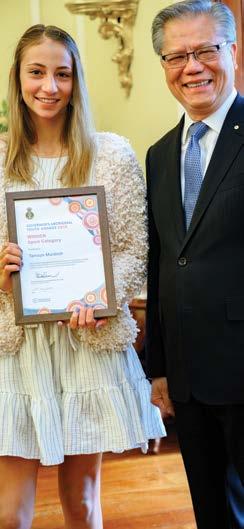
16 minute read
Youth recognised at Government House
Young South Australians with impressive achievements in sport, the arts and higher education have been recognised at a formal award ceremony for the 2019 Governor’s Youth Awards
The Awards were presented by the Governor of South Australia, His Excellency the Honourable Hieu Van Le AC and Mrs Le at Government House on 28 May 2019.
Advertisement
The Governor presented one award in each of three categories – Arts, Sport and Higher Education.
Winners this year were: Sport – Tamsyn Murdoch, Higher Education – Arabella Hart, Arts – Nathan May.
The Governor’s Aboriginal Youth Awards recognise young South Australians aged between 15 and 29 years, who are showing potential and determination to achieve success, or who are excelling in their chosen field.
The inspiring award presentation was attended by Members of Parliament, senior academics, current and former commissioners, Aboriginal elders, many community and family members and young people.
Each winner in each category receives a certificate of recognition, a $3,000 bursary and the support of a mentor to assist in their career development.
Tamsyn Murdoch is a young woman of Nyikina and Yawuru descendant, who gained recognition for her success in athletics’ multi-event discipline, heptathlon.
In presenting her award, the Governor said that Tamsyn had shown the commitment and drive required to be successful at the highest sporting levels, as well as providing leadership and inspiration to other young Aboriginal people.
Tamsyn told Aboriginal Way after the presentation that she was very pleased and surprised to be recognised at the Awards this year.
“I’m just very shocked and overwhelmed, was not expecting it” she said. Although only 16 and still at school, Tamsyn has been doing athletics for many years.
“I’ve been in the sport of athletics for over ten years now. I started off doing athletics as individual events, so mostly long jump, hurdles, high jump. It wasn’t until I started finding coaching that I moved towards a heptathlon coach specialist. And he got me into the sport of heptathlon” she said.
Heptathlon is a challenging sport that involves seven events over two days. On the first day there are four events: 100 metre hurdles, high jump, shot put, and 200 metres. Then the next day there are three events: long jump, javelin, and 800 metres.
Not surprisingly, training for an event like this is quite intense, Tamsyn explained.
“At the moment, I’m doing up to four to five days of training a week, on top of school and trying to fit in work.
“One day includes roughly two and a half hours of training. There’s warmups,
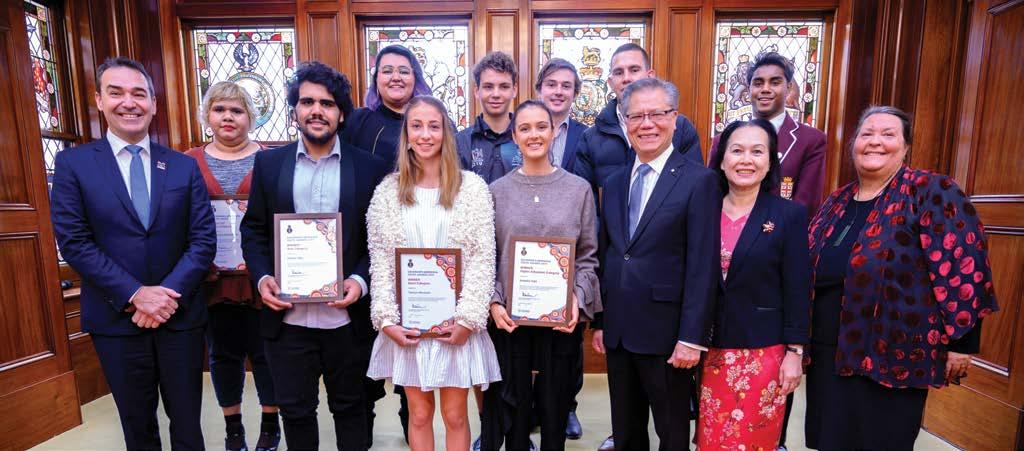
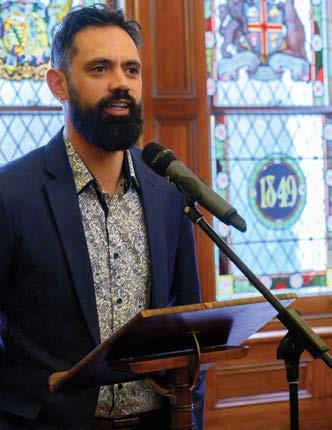
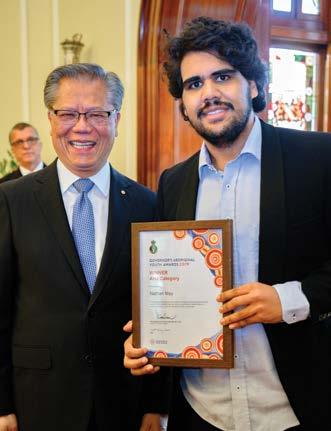
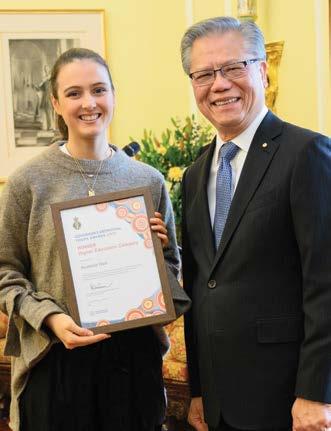
This page, left to right from top: Tamsyn Murdoch with the Governor; All award winners and finalists with the Premier Steven Marshall, Governor and Mrs Le and Professor Irene Watson; Jack Bucksin welcomes all to country; The Governor with Nathan May; The Governor with Arabella Hart.
then more so getting into techniques, endurance running, and then a good warm down session.
Tamsyn has another award on her shelf – she was recently awarded the Athletics SA Most Promising Multi-Event Athlete trophy.
“I’ve been nominated twice over the last two years, and I was runner up last year. And I was lucky enough to win it this year, 2019. It’s pretty much everyone who competes in a heptathlons, multi-events, or decathlons. Their results over the season get looked at by the board, and pretty much whoever has shone through, gets the award” she said.
She will also represent Australia in the upcoming Oceania Games in the under 18s category, although she is still eligible to compete in the under 16s category.
“For me to actually be nominated for the Oceania Games, I had to win the whole of my last competition, I won that with very, very good results, competing against older girls. “Then I think probably just under a month ago we got an email saying that I’ve made it in, along with one other girl that I’ve competed against for a while. So we’re going to compete in the Oceania Games, up in Townsville, in Queensland this year, it’s pretty exciting!” she said.
Tamsyn says that her ongoing successes, as well as the support of her family motivates her to keep working hard on her sport performance.
“Seeing how successful I’ve become keeps me going. It’s a lot of hard work. You can’t just half ass everything. And just being able to have the support from family, friends, coach. It pushes you a long way” she told Aboriginal Way.
The Arts Award was awarded to Nathan May, a talented singer/songwriter who descends from the Arabana, Yawuru and Marridjabin clans. The award citation said “Nathan has tapped into his talent to develop creative ways to share his experiences and provide guidance to other young Aboriginal people through school-based music programs.” Nathan performed a beautiful original song at the awards ceremony, which touched and impressed all present.
The Higher Education award was presented to Arabella Hart, who descends from the Bagala clan within the Jawoyn nation.
The Higher Education Award is allocated to the Aboriginal student who achieves the highest grade point average across three South Australian universities.
Currently a third year Bachelor of Pharmacy (Honours) student at the University of South Australia, Arabella hopes to work within a clinical and hospital setting, with a particular interest in cardiovascular-related pharmacotherapeutics and related therapeutic decision making.
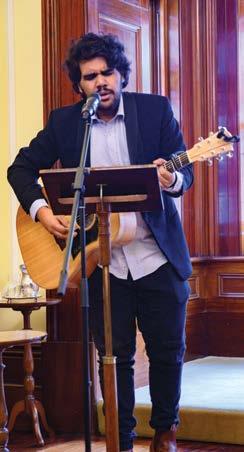
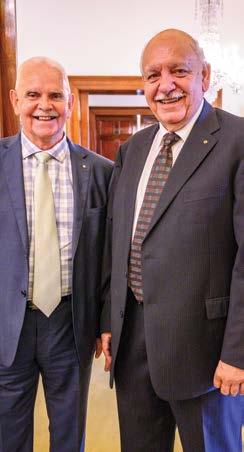
For more information on the Governor’s Youth Awards, head to: www.dpc.sa.gov.au/responsibilities/ aboriginal-affairs-and-reconciliation/ governors-aboriginal-youth-awards
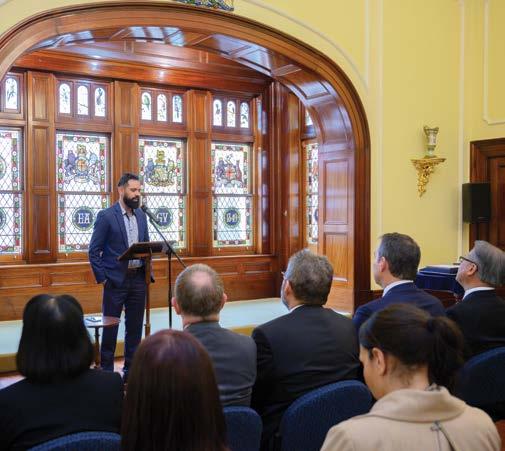

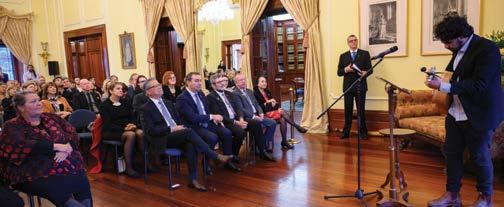
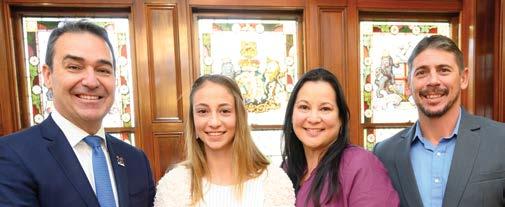
This page, left to right from top: Professor Irene Watson; Nathan May; Frank Lampard and David Rathman; Jack Buckskin; April Lawrie with Natasha Chisholm; Nathan May peforms; Premier Steven Marshall with Tamsyn Murdoch and her parents.
Look again at Dark Emu

in review
Throughout history, humans have looked to the night sky to help explain their existence, but the conclusions peoples draw from the same sky can be remarkably different. European astronomy uses constellations of stars to tell a story, but sometimes Aboriginal Australia uses the darkness between the stars. Dark Emu is a shape in the dark areas between the stars of the Milky Way. It’s a different way of seeing. So begins Bruce Pascoe’s Young Dark Emu, a beautiful new version of his award winning and influential book Dark Emu, this edition created for younger readers. Using the first-hand accounts of early European explorers, colonists and farmers, Bruce Pascoe (pictured left) argues for us to look again at the ‘hunter-gatherer’ label that was given to pre-colonial Aboriginal people. With clear text, striking archival photographs and stylised illustrations, Young Dark Emu takes the reader through a journey of re-discovery about Aboriginal culture. It was a culture that understood and used agriculture and aquaculture to survive in the continent’s diverse environment, Bruce Pascoe argues. It was a culture that had established homes, villages, social structures and sacred places, he demonstrates through a careful exploration of original evidence. There was Lieutenant Grey, who explored Western Australia and witnessed huge tracts of planted yam fields. Victorian farmer Isaac Bates reported that Aboriginal people had terraced the land for erosion protection over ‘a long series of years’ before his arrival. Explorer Thomas Mitchell came across substantial crops of a wheat-like grain with hay stacks with grain harvested and stored. Arthur Ashwin found several stockpiles while travelling through the Barkly Tableland in northern Australia, including one he estimated to be hold one ton of seed.
Evidence of Aboriginal peoples’ aquaculture activities can be seen today in the Brewarrina fish trap, estimated to be at least 40,000 years old. The large structure allowed people to harvest the fish they needed, while allowing enough fish to survive and be sustainable. There were many more descriptions of Aboriginal people farming water resources, but most physical evidence has been destroyed. European settlers found Indigenous peoples’ fire management techniques alarming as ‘many early records describe Aboriginal groups lighting fires to burn areas of land’. It became clear that burning practices were carefully managed and had the effect of controlling the intensity of wild fires as well as adding nutrients to the soil and keeping areas clear for farming. Young Dark Emu touches on the perspectives of the early European settlers and explorers and the devastating effects their arrival had on Aboriginal peoples. These impacts came not only from the frontier wars that followed ‘the land grab’ and disease, but also from the destruction of long-established Indigenous land management practices. The newcomers destroyed indigenous croplands so quickly that Aboriginal people were forced to depend on British food. The combination of deaths from fighting disease and starvation crushed the Aboriginal resistance. While covering complex issues that go to the heart of Australia’s ancient and contemporary history, Young Dark Emu is sure to intrigue and inform its readers, as well as influence them to look again at our assumptions and shared history.

Narungga online
Narungga Nation Aboriginal Corporation (NNAC), the native title group for country on the Yorke Peninsula have launched a new website.
Business Manager Garry Goldsmith said that the website had been in development since it was proposed while he was Chairperson of NNAC and aims to assist both Narungga community members and the general public. “It was firstly created as a mechanism to communicate with our members on all Narungga matters and as a way for our members to contact Narungga in relation to any individual personal matters that we could assist with” Mr Goldsmith said.
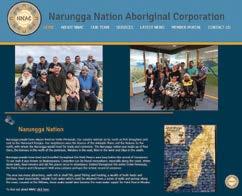
“A member’s portal is a key part of the site, eligible members can access the portal by contacting Narungga Nation via the website.
“The site is also a place to share information for the wider community, particularly around commitments held in the Buthera Agreement” Mr Goldsmith said.
“The site was also set up to be able to provide info on NNAC’s activities and achievements and also promote some of the key works we are doing, “It’s one way for the organisation to be open and transparent to all members and the wider community” he said.
“The site has now been launched and will continue to include updates and improvements” Mr Goldsmith said.
Check it out at: www.narungganation.com
Barngarla nuclear ballot dispute dismissed
The Federal Court has dismissed the Barngarla people’s case against a proposed ballot about the placement of a National Radioactive Waste site near Kimba.
Justice White has ruled that the planned ballot to gather opinions of residents about the site by the Kimba District Council did not contravene the Racial Discrimination Act.
The Barngarla people had claimed in court that the ballot discriminated against them as native title holders and so as Indigenous people. The process for the planned ballot meant freehold land owners who lived outside the area would have a vote, while native title holders who lived outside the area would not. Lawyers for Barngarla had argued in court that breached the Racial Discrimination Act.
Outside the Federal Court following the hearing, SA Greens MLC Mark Parnell said “It’s just an incredible disappointment that Traditional Owners are denied a say on a nuclear waste dump on their country”. In a statement reported in the Transcontinental, the Barngarla people said they respected the federal court’s decision, but would consider further legal action. “The Barngarla respects the decision of the federal court, as the court has to interpret complicated legislation” the statement read.
“However, more generally we consider it sad that in the 21st century we are required to take legal action to allow us to have the right to vote on the major decision of the day. “This case has been about standing up for the right of Aboriginal people to vote on important issues which affect their rights.” The case has delayed a final decision by the Federal Government on the location of the Radioactive Waste site, as well as a similar ballot planned over a possible site in the Flinders Ranges on Adnyamathanha country. In a media statement the Department of Industry Innovation and Science said that it welcomed the decision of the court.
“Consultation has remained open during the proceedings and we continue to encourage people both for and against the proposal to make their views known by making a submission. “The Department will examine the decision before advising the communities who voluntarily entered the process, of the next steps.” The dispute was first heard in the Supreme Court and was then referred to the Australian Human Rights Commission for mediation. When the parties could not reach agreement, the matter was put before the Federal Court.
to five-year strategic direction. The current NILSS includes future directions, key strategies and the sectors the organisation focusses on.
The RILSS provides an additional layer to that planning, based on the characteristics and aspirations of each region.
The ILSC divides the nation up into four regions, South West Australia, Northern Australia, Desert Australia and South East Australia (see map left). South Australia is within both the Desert and South East Australia regions.
At the Adelaide consultation in May, questions put to Aboriginal Corporation representatives present included:
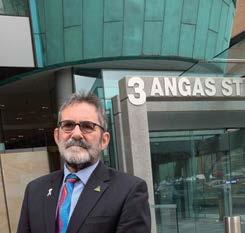
ILC expands, becomes ILSC
The national organisation established to purchase, manage and transfer land to Indigenous corporations has undergone a significant expansion of its role and is now also concerned with water interests.
Legislation that passed Federal Parliament in late 2018 and came into effect 1 February 2019 saw the Indigenous Land Corporation (ILC) become the Indigenous Land and Sea Corporation (ILSC), with an extended role to deal with interests in water as well as land.
The ILC was originally established in 1995 and is governed by the Aboriginal and Torres Strait Islander Act 2005 (ATSI Act). The organisation has been partnering with Indigenous organisations to manage land since that time. The central functions of the expanded organisation are now to: a. acquire interests in land and water related rights for the purpose of divesting those interests to
Indigenous entities; and b. manage Indigenous held interests in land and water related rights. This focus, along with the funding that supports the organisation’s activities means that it can play a significant role in the development of Indigenous corporations. South Australian native title groups and PBCs are encouraged to contact the ILSC to discuss possible ways of collaborating. In fulfilling its functions, the ILSC is required to create social, cultural, economic and environmental benefits for Indigenous Australians with a legislatively mandated priority towards social and cultural benefits. Following the expansion of its business, the ILSC conducted consultations across Australia to seek the perspectives of Indigenous peoples on managing sea (both salt and fresh) country. A forum was held in Adelaide on 8 May 2019 and those present at the session heard that the ILSC’s functions in water will be similar to its functions in relation to land:
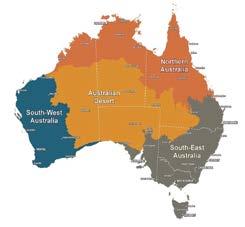
• the acquisition of water-related rights and divestment to Aboriginal or Torres
Strait Islander Corporations; and • the provision of assistance (grants, loans or loan guarantees) to Aboriginal or Torres Strait Islander Corporations to acquire water-related rights. The ILSC is now considering its approach and future strategies. It is developing new strategy documents to inform its work over the next five years – the National Indigenous Land and Sea Strategy (NILS) and Regional Indigenous Land and Sea Strategies (RILSS). The NILSS is the key policy document at a national level, setting out the three What kind of water-based projects offer the most opportunities to Aboriginal and Torres Strait Islander groups in your region?
Bearing in mind the limited resources of the ILSC, what role can it play to best support Aboriginal and Torres Strait Islander groups to achieve benefits from country in your region?
Discussion took place around those questions, as well as the key networks relating to water interests in the South Australian regions and some of the roadblocks that those people had found in working on water-based activities.
When complete, the ILSC’s new strategy documents, the NILSS and RILSS, will be available on the website.
For more information: www.ilsc.gov.au ILSC Policy team (Adelaide): (08) 8100 7100 SOUTH AUSTRALIAN NATIVE TITLE SERVICES
Level 4 345 King William Street ADELAIDE SA 5000
Editor Keith Thomas
Communications Officers Lucy Kingston Kaliah Tsakalidis
Designer Alison Fort
Advertising Enquiries (08) 8110 2800
Circulation 10,000
If you have any stories of interest to our readers, please address any correspondence to:
editor@nativetitlesa.org
Aboriginal Way South Australian Native Title Services Level 4 345 King William Street ADELAIDE SA 5000
Ph: 8110 2800 Fax: 8110 2811 FREECALL: 1800 010 360
The Editor has the final decision on all stories and advertising that appear in this publication.
w w w.nativetitlesa.org

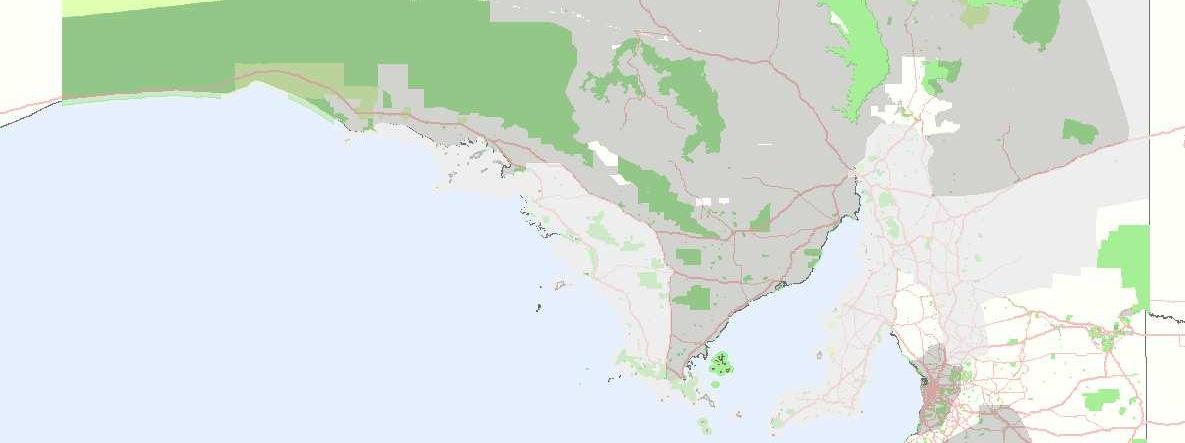
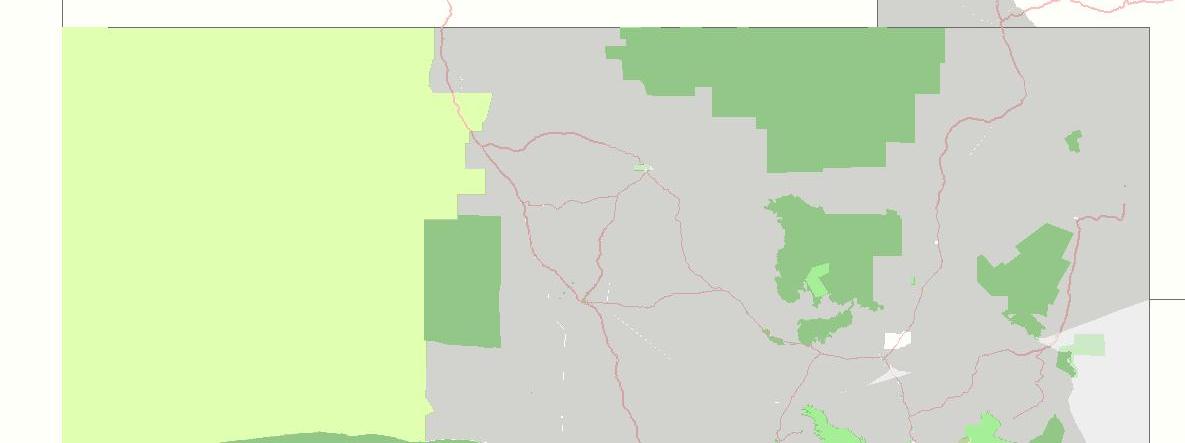
Tjayuwara Unmuru Compensation Application
De Rose Hill
De Rose Hill Compensation
Application
Legend Native Title Determination Area (NNTT name shown) Native Title Applications coloured (NNTT number and name shown) Land Tenure Aboriginal Freehold Reserve/Park
Far West Coast
MINTABIE Tjayiwara Unmuru
Eringa
Irrwanyere Mt Dare Eringa Part A Proceeding The Wangkangurru/Yarluyandi Native Title Claim
Wangkangurru/Yarluyandi Part A Proceeding
Eringa No. 2 and Wangkangurru/Yarluyandi
Yankunytjatjara/
Antakirinja SC2013/001 Arabana No 2 SC2018/002 Walka Wani Oodnadatta #2
SC2013/003 Walka Wani Oodnadatta
Arabana People
Dieri No. 3 Dieri Yandruwandha/ Yawarrawarrka
Antakirinja Matu-Yankunytjatjara
COOBER PEDY ! (
Gawler Ranges People Adnyamathanha No 1 - Stage 3
SC2013/001 Arabana No 2
Adnyamathanha People No. 1 (Angepena Pastoral Lease) Dieri No.2
Adnyamathanha People No.1 (Stage 1) SC2015/002 Malyankapa Peoples
Kokatha People (Part A)
ROXBY DOWNS ! (
LEIGH CREEK
WOOMERA ! ( Adnyamathanha People No. 3 Adnyamathanha People No. 2 Adnyamathanha No. 1
Adnyamathanha No 1 - Stage 2
SC2016/001 Far West Coast Sea Claim
0 100 200
CEDUNA
STREAKY BAY ! (
SN2019/001 Attorney General for South Australia (Wirangu)
Kilometres
Geocentric Datum of Australia 1994
Prepared by: Geospatial Services, National Native Title Tribunal 4/07/2019
SC1997/006 Wirangu No. 2 Native Title Claim
SC2018/001 Nauo #3
SC1997/008 Nauo Native Title Claim Barngarla Native Title Claim
PORT LINCOLN PORT AUGUSTA SC1996/004 Barngarla Native Title Claim
WHYALLA ! (
QUORN
Adnyamathanha, Ngadjuri and Wilyakali Overlap Claim
SC1996/005 Nukunu Native Title Claim
PORT PIRIE PETERBOROUGH ! (
JAMESTOWN ! (
SC2011/002 Ngadjuri Nation #2 SC2012/001 Wilyakali
SC2013/002 Narungga Nation
CLARE ! (
Kaurna Peoples
First Peoples of the River Murray & Mallee Region
BERRI
ADE LAIDE
SC2016/003 Nauo No. 2
MURRAY BRIDGE
Ngarrindjeri and Others
SC1998/004 Ngarrindjeri and Others Native Title Claim
South Australia
Native Title Applications and Determination Areas As per the Federal Court (04 July 2019)
SN2017/001 Minister for Environment, Sustainability and Conservation for and on behalf of the Crown in right of the State of South Australia (Mount SC2017/001 Magnificent Conservation Park) First Nations of the South East #2
BORDERTOWN ! (
KINGSTON S.E.
SC2017/002 First Nations of the South East #1
MOUNT GAMBIER ! (
Get Aboriginal Way
Individuals or organisations can request free copies of this publication. Complete the form below and mail to 4/345 King William Street, Adelaide 5000 or email details to editor@nativetitlesa.org Name: __________________________________________________ Address: ________________________________________________ Postcode: _____________
ISSUE 75 Phone: __________________________________________________ Email: __________________________________________________ No. of copies: ____________________________________________
…airs weekly on Indigenous and community radio. If you have an interesting story or event that you would like to share on radio, please contact Lucy Kingston on (08) 8110 2800 or email editor@nativetitlesa.org Listen online at https://www.nativetitlesa.org/aboriginal-way




